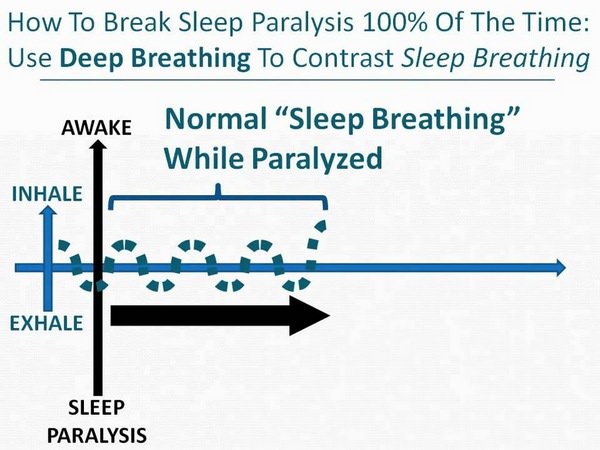The Art of Waking Sleep Paralysis
Here's the big secret that I wish I had known when I first got started with lucid dreaming. You're about to find out why waking sleep paralysis is the holy grail for lucid dreamers and out of body explorers because it's how you can access an unconscious state without having to use any visualizations at all.
If you've ever woken up in the morning and found that you couldn't move or make a sound for a few minutes, you've had sleep paralysis. This used to happen to me and I had no idea why or what it was.
But as it turns out, this was the trick that opened the door to frequent OBEs, after having insomnia for years.
Sleep Paralysis Protects You During Sleep
Sleep paralysis is a protection mechanism your body uses when you fall asleep.
If you were to dream you're doing something very active, such as running, and you weren't in sleep paralysis then you would move your limbs when you're asleep and you'd wake yourself up.
To prevent that from happening, your body disconnects your voluntary muscle system from your mind so that you can dream all you like without waking yourself up.
Usually you enter a state we might call "Mind Asleep, Body Asleep".
You're not aware that of this happening because by the time your body shuts itself down into sleep paralysis, your mind is already asleep and unaware of what's happening.
What we want is more like "Mind Awake, Body Asleep".
The whole trick to lucid dreaming is to enter a unconscious focus without losing awareness. Here's how waking sleep paralysis does this for you.
Sleep Paralysis Puts You in an Unconscious Focus Automatically
When you're awake, your brain is in what's called a 'beta' state. Beta means your dominant electrical brainwave frequencies are oscillating at around 16 to 31 cycles per second.
When you enter sleep paralysis, your brain automatically puts itself in "dream mode" which is called a 'theta' state. Theta is slower than beta and is around 4 to 7 cycles per second.
Knowing this secret allows you to avoid one of the major mistakes most people make when attempt to have OBEs.
The Great Mistake
Most books on OBEs say to simply induce an OBE in what is basically a one-step process.
Going directly from a waking state to an OBE is possible - but it's difficult. This is not what I recommend you start out with.
Instead, you'll progress much faster by making it a two-step process.
First you'll use a subtle sleep command to trick your body into falling asleep and entering sleep paralysis.
Then you'll choose an exit techniques to convert waking sleep paralysis into an OBE (or lucid dream).
Most People Discover Sleep Paralysis by Waking Up in it
The way you'll usually become aware of sleep paralysis is that you wake up in it... and find you can't move or make a sound.
Waking sleep paralysis often feels like there's a heavy lead blanket on you. It's not that there is really anything on you or that your muscles have become weaker.
The feeling is because your brain has to send a stronger nerve signal than normal to get the same muscle movement. That makes it feel like you're having to overcome some kind of resistance when you try to move.
This feeling also usually makes it feel like it's harder to breathe, but remember it's actually a natural sleep process. Sleep paralysis happens every single time you fall asleep.
Is Sleep Paralysis Dangerous?
You may be wondering if waking sleep paralysis is dangerous and if there's a way to break free.
Sleep paralysis is not dangerous because it's something your body does every night.
Plus, here is a secret "safety release" trick you can use to free yourself from paralysis so you always have a backup plan.
How to Break Sleep Paralysis 100% of The Time
The only way your body knows for sure if your mind is awake is if you move. This is a problem when you're in sleep paralysis which is preventing you from moving.
Luckily waking paralysis is limited to your voluntary muscle system like your arms and legs. Your breathing is semi-involuntary so you still have control over it even in deep paralysis.
If you enter sleep paralysis and decide you want break free and wake up, simply change your breathing pattern to something other than the sleep breathing pattern your body is in. The most effective way I have found to do this is to begin breathing deeply and slowly.
After 10 or 15 seconds your body will notice the change and bring you out of the paralysis.
Not many things are 100% reliable in lucid dreaming but this has worked for me every single time.

Find Out if You Have Sleep Apnea
A very few people have reported that they woke up in sleep paralysis and noticed that they weren't breathing at all. The problem is not the paralysis itself, but that they had an existing health condition called sleep apnea.
Sleep apnea basically means that you stop breathing when you're asleep. So this is an added bonus of using waking sleep paralysis to have OBEs: you'll find out whether or not you have sleep apnea.
Keep in mind there's a big difference between the normal "heavy lead blanket" feeling that comes with sleep paralysis versus not breathing at all. If you find you stop breathing entirely then you may have sleep apnea and should see a doctor about it.
If you only feel the heaviness sensation then everything is normal.
Accidental Vs Deliberate Sleep Paralysis
So far we've talked about accidentally waking up during sleep paralysis. However that's basically an uncontrolled and accidental process.
The question is what can you do to make it happen consistently to produce lucid dreams?
Inducing Sleep Paralysis
The idea is to flip the sleep order around... so that instead of entering "body awake, mind asleep", you enter "mind awake, body asleep".
When this happens you're actually aware of the process your body goes through when it falls asleep. This is the big secret for having visualization-free lucid dreams and OBEs. This transition is the most important skill to learn in this part of the course.
Why? Because when you can put your body to sleep without losing consciousness at any point, you have 100% perfectly clear dream recall. This is called a Wake Induced Lucid Dream (WILD).
It's as easy to remember what you did in a WILD as it is to remember the last 15 minutes or so of normal waking awareness. With this method, you don't have to think back through and hazy dream phase like you normally do with most dreams.
What Does it Feel Like to Induce Sleep Paralysis?
Instead of waking up in sleep paralysis and with the heavy lead blanket feeling, deliberately induced sleep paralysis is more like having the sensation of the heavy lead blanket being laid on your chest.
It often feels like it begins at your feet, comes up over your chest and ends at your head. When that process is complete you're in sleep paralysis.
So how do you get this process to happen consistently?
Here is the key. This single fact is so critical that I'm giving it a big fancy name. It's called the "Fundamental Theorem of Sleep Paralysis".
The Fundamental Theorem of Sleep Paralysis
The Fundamental Theorem of Sleep Paralysis is that if you wake up and fall asleep without moving at all, sleep paralysis becomes extremely likely.
When I say without moving I really mean it. You don't move or open your eyes, don't scratch any itches, don't twitch at all in any way.
You're exploiting the fact that your body doesn't really know for sure if your mind is actually awake or not. If you don't give it any signals otherwise, it will assume that the mind really is still asleep and re-paralyze itself.
The Next Step: The "Stop, Drop & Roll" Sleep Commands
The foundation skill you need to develop this knowledge into a full-blown lucid dream or OBE is to fall asleep quickly.
So in the next lesson I'll show you how you can make your body first ask for permission to sleep... then how you can tell it "yes it's time to fall asleep".
This trick is called the "stop, drop and roll" sleep command and once you have it down you'll never have trouble getting to sleep again.
 About The Guest Author
About The Guest Author
Nick Newport is the author of Lucidology, a website that teaches how to have lucid dreams and out of body experiences from a waking state.










